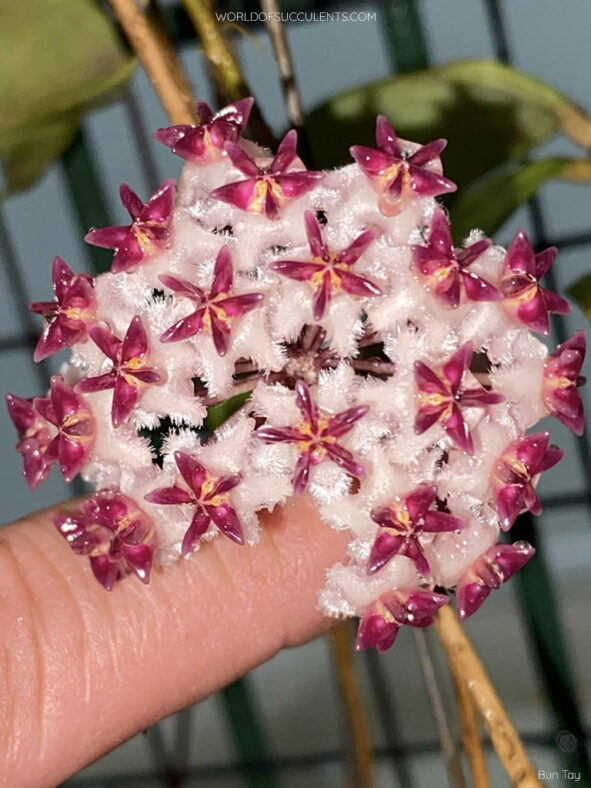Hoya erythrostemma is one of four Hoyas in the Mindorensis Complex, along with Hoya mindorensis, Hoya elmeri, and Hoya rintzii.
Scientific Name
Hoya erythrostemma Kerr
Synonym(s)
Hoya mindorensis subsp. erythrostemma
Scientific Classification
Family: Apocynaceae
Subfamily: Asclepiadoideae
Tribe: Marsdenieae
Genus: Hoya
Etymology
The specific epithet "erythrostemma" (pronounced er-rith-ro-STEM-a) means "red-crowned" and refers to the red corona of the flowers.
Origin
Hoya erythrostemma is native to Thailand and probably Malaysia. It grows as an epiphyte along rivers and streams in the lowlands.
Description
Hoya erythrostemma is a beautiful climber with wiry stems that bear fleshy, green leaves with light green venation. The leaves are elliptical with a pointed tip and can measure up to 6 inches (15 cm) in length and 2 inches (5 cm) in width. Under sunny conditions, the new growth can take on a pretty red color.
During the summer, Hoya erythrostemma produces lovely round clusters of up to 40 flowers, which last for two weeks. The corolla is about 0.4 inches (1 cm) in diameter and has spreading to reflexed lobes that vary in color from white to pinkish. The corona is deep pink or red and about 0.3 inches (7.5 cm) in diameter.

How to Grow and Care for Hoya erythrostemma
Light: It's best to keep this plant indoors in bright, indirect light. Even though it can tolerate lower light levels, it may become weak and leggy if the light is too low, producing fewer leaves and flowers.
Soil: Well-draining soil that provides excellent aeration and does not hold too much water is most important for growing a healthy plant.
Temperature: Hoya erythrostemma thrives in hot and humid climates, so keep it away from drafty windows and doorways during the colder months. It grows best in USDA Plant Hardiness Zones 11a to 11b, with average minimum winter temperatures ranging from 40°F to 50°F (4.4°C to 10°C).
Watering: Since this plant is sensitive to overwatering, soak the soil thoroughly in spring and summer, but allow it to dry out before watering again. Otherwise, you will increase the risk of root rot, and your plant will not be happy. It is relatively dormant during the fall and winter, needing only moderate watering.
Fertilizing: Although Hoya erythrostemma is not a heavy feeder, it can benefit from a high-potassium fertilizer at half strength every two weeks during the growing season.
Repotting: As an epiphyte, this plant has a shallow root system and does not require a deep container. It also does not require frequent repotting. It prefers to be slightly root-bound, so repot it in spring only if it has outgrown its container.
Propagation: Although layering is the easiest way to propagate Hoya erythrostemma, using stem cuttings is the most popular method. Using leaf cuttings can be more challenging, while starting it from seeds is the simplest but the most time-consuming method. For best results, take cuttings only when the plant is actively growing. Sow seeds in spring and summer.
Learn more at How to Grow and Care for Hoya.
Toxicity of Hoya erythrostemma
Hoya erythrostemma is considered non-toxic, so it is safe to have around kids and pets.
Links
- Back to genus Hoya
- Succupedia: Browse succulents by Scientific Name, Common Name, Genus, Family, USDA Hardiness Zone, Origin, or cacti by Genus
Photo Gallery
Click on a photo to see a larger version.


